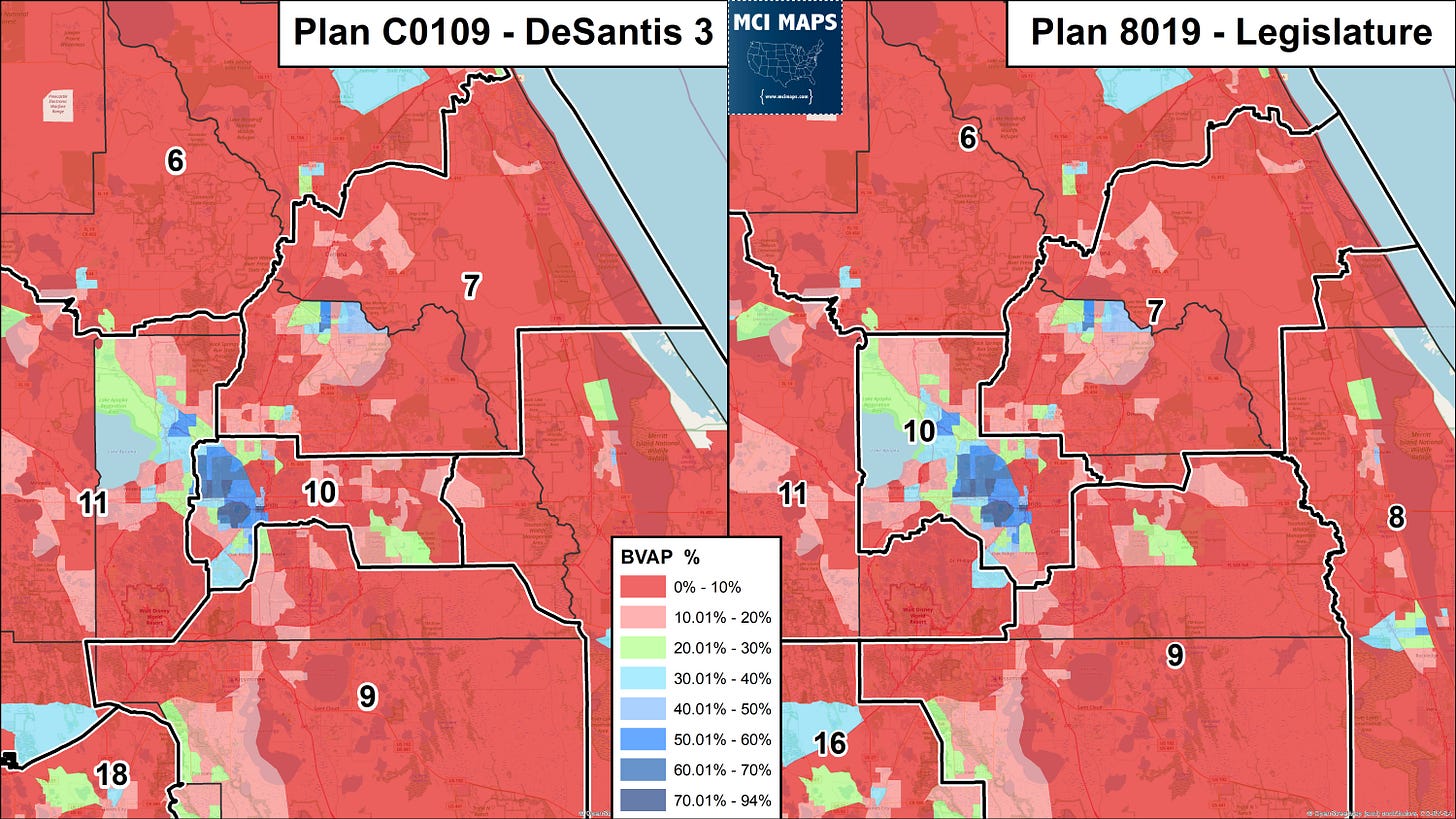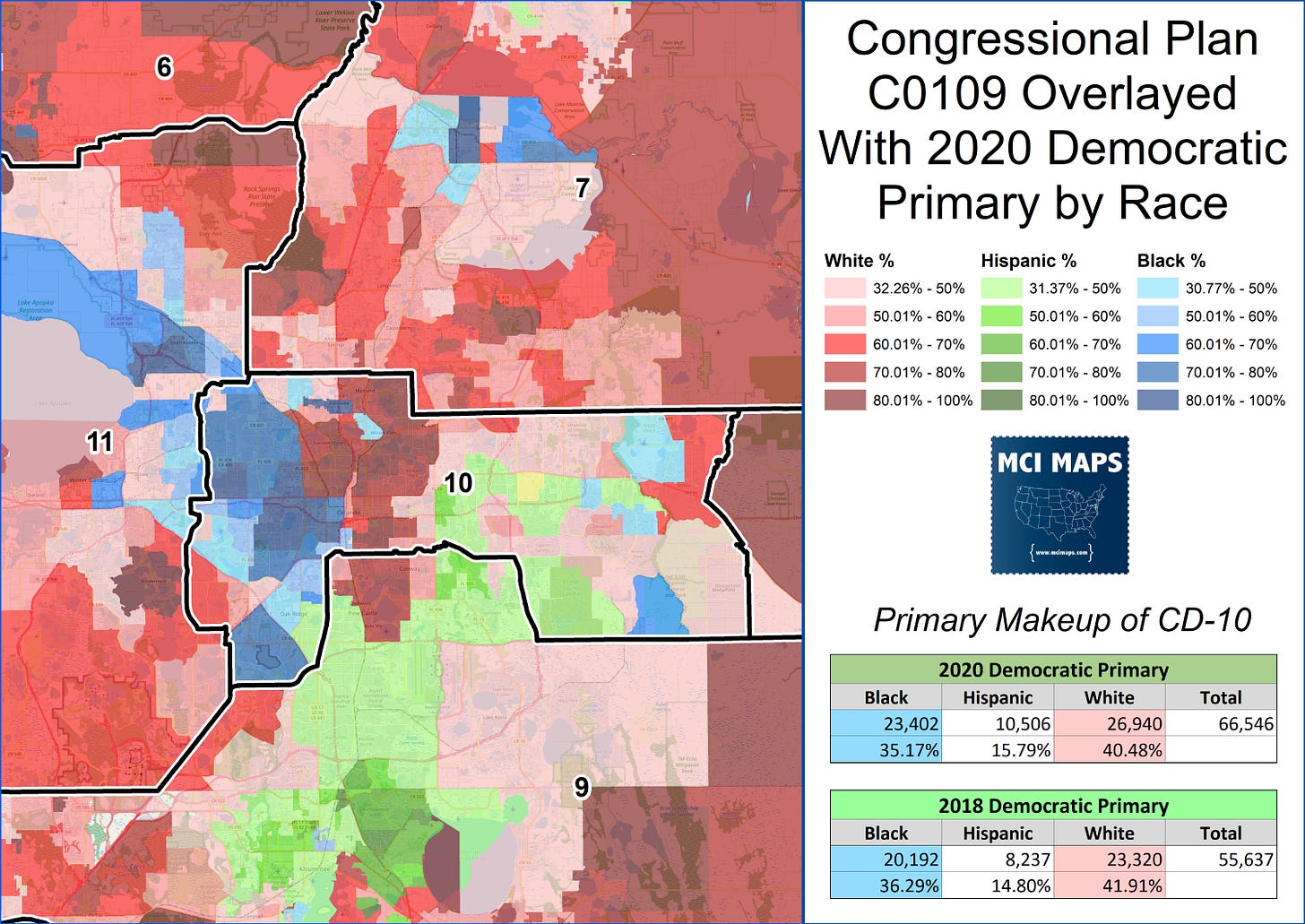Issue #123: Florida's Redistricting Battle Narrows to the FL-05
A two week trial will now be a one-day hearing
Florida’s redistricting saga has taken a major left-turn in the past few days. Initially, a trial was expected to start on August 21st in state court over the Congressional map that Ron DeSantis rammed through the Florida legislature. One major item the lawsuit focused on the destruction of the 5th Congressional district, which was initially drawn to unite the black community of North Florida.
A seat for the North Florida black community has taken multiple shapes over the years, and I documented the history and reason for its creation here. Here is how it looked in 2020, its last year in use.
The suit also took aim at the line drawing in Tampa and Orlando, where Republican map-makers ensured Democratic gains in the region were confined to a handful of safe districts.
Then on Friday, the state and the plaintiffs came to an agreement that radically shorted the case. The fight now is purely over the 5th District and the Fair Districts Amendments of Florida.
Lets talk about what is going on here, and why I think the old Florida 5th has a good chance to come back by 2024.
Background and Lawsuit
I have written about Florida’s redistricting saga so much that its honestly hard for me to know what my readers know off the top of their head vs what I should remind them of. So here is a short, short, SHORT version of the 2022 situation.
If you would like maps or hard data on any of the things I reference here, its likely I have it in one of countless articles. For easy sorting, here are some key links
Every substack I’ve written tracking the 2021-2022 Redistricting Saga in Florida
Longer-form redistricting articles from my main website
My series on the redistricting history over the decades in Florida
Lets delve into some bullet point history
In 2010, Florida voters passed Fair Districts, which protected minority voter seats that performed, not just 50%+ districts that the VRA covers. The measures also ban political gerrymandering and have compactness requirements.
In 2015, the Congressional maps passed in 2012 were struck down for racial and political gerrymandering. The remap moved the 5th district from a Jacksonville to Orlando seat to a Jacksonville to Tallahassee seat. The overall map gave both parties more opportunities, with fewer SAFE districts
Heading into 2021, even though the Florida Supreme Court was by then more conservative thanks to retirements, the lawmakers did not want extended trials, and appeared to desire a “least change” approach
The Senate passed a Congressional map that conservative activists hated. The map was very balanced and kept the 5th in the same Tallahassee to Jacksonville style. The House map had more gerrymandering in Tampa and Orlando, but also aimed to keep the 5th as it was in North Florida
In January of 2022, Ron DeSantis offered his own proposals, which were very gerrymandered. They destroyed the 5th district, cracking the black population of North Florida. The final proposal would be 20 Trump seats and 8 Biden seats.
Lawmakers pushed back for some time, but a compromise plan passed was vetoed by the Governor
In a special session, facing threats of vetoes and primaries, lawmakers caved and passed Ron’s proposal. The session ended with several members of the black caucus staging a sit-in.
A lawsuit was filed, and while a judge ruled the new map violated black voter protections in North Florida, the ruling was stayed pending appeal and the clock ran out for 2022.
The lawsuit over the maps continued. In fact there is cases in state and federal court. I’ve long maintained the state case has a better opportunity, since it relies on the state’s Fair Districts Amendments; which are broader than federal mandates.
I covered the fight over Fair Districts in this article, they passed with 62% of the vote in 2010. They were made up for two measure, both which got near identical votes. Amendment 5 covered state legislative seats, and Amendment 6 covered Congressional.
From Fair Districts, and from court rulings from 2012 through 2015, we have a strong understanding of what constitutes a minority performing seat in Florida. The standard does not just rely on a district being 50% black, or 50% Hispanic. Seats can be considered protected if Functional Analysis shows the district elects candidates of a minority groups choosing.
In the case of the 5th district, this is how the Functional Analysis plays out for the 2020 version of the seat, aka the benchmark. This was laid out in redistricting cases I covered here.
The district was around 46% black voting-age population
The district was overwhelmingly Democratic, not just by registration but by partisan performance at the top of the ticket.
The Democratic primary, which is tantamount to election, was at this point around 70% black, meaning black voters control the primary.
In practice, the district performed for black voters.
This standard is well documented in Florida case law. The rules are also used for Florida’s legislative districts. Several black-performing seats are under 50%, but perform via the primaries. On the other side of things, the Functional Analysis is used to ensure if a Hispanic-majority seat actually performs for Hispanic voters. Sense Hispanic voters have weaker turnout than black or white voters, and have a larger non-citizen population, the functional analysis process helps show if a 55% Hispanic VAP seat is actually Hispanic in terms of voting power.
So these are the rules around minority representation in redistricting, and they matter when it comes to the state lawsuit filed.
The complaint filed by the plaintiffs had three main Counts
The map diminished black voter representation
The DeSantis admin purposely aimed to diminish black voting power
The maps overall are partisan gerrymanders
This was what a two week trial was going to focus on. However, the scope has now changed.
The Stipulation Agreement
In the stipulation agreement that both sides laid out Friday, the following compromises were made. You can read it in full here.
The plaintiffs agree to the following
Plaintiff’s Count 1, racial diminishment, is solely focused on North Florida
The plaintiffs dropped Count 2. They no longer will fight over DeSantis’ intention
The Plaintiffs dropped Count 3. Fight over other partisan redistricting is settled.
In exchange for this, the state agrees to the following
The State agrees that the destruction of the 5th district DOES violate Fair Districts
The State will only argue that the Fair Districts rules on racial consideration violates the Federal Constitution - namely equal protection.
The State agrees that if they lose in the courts, the remedy is to recreate a Tallahassee to Jacksonville 5th. Nothing just in Duval County.
The State agrees that a draft map (exhibit 2) is an acceptable remedy for the court to enact if the state fails to deal with the matter if they lose in court. I’ll talk more about this map later in this post.
Both sides agree to the following as well
The court will hear arguments for one day on the fight over if Fair Districts is constitutional. Date is August 24th.
The loser can appeal, but will do so directly to the FL Supreme Court under an expedited schedule.
The goal is that the Supreme Court of Florida will rule by the end of the year, giving lawmakers time to pass a new map if needed.
If the old map is struck down and a new map is not done by April, the court can/will take over the process to ensure 2024 is held under new lines
So a two-week trail about several parts of the state has now narrowed to a one day hearing that would only effect North Florida. Why is this?
Why Agree to the Stipulation?
So when I posted about this over the weekend, I had several angry responses. “Why are they giving up on Orlando and Tampa??!!!” I get it, it can be frustrating if you are there. Let me offer my opinion on why I think the plaintiffs made this deal, and why I think it was smart.
So lets start with Count 1 of the complaint, the racial diminishment, narrowed to just North Florida
The stipulation narrows this to North Florida. Why not elsewhere? Well, a case about this, namely that you had a district that once performed for minority voters but has now been erased, has to show a minority-performing seat could otherwise be drawn.
In Tampa, there is no district in question to be debated. That area is partisan gerrymandered. However, no black or Hispanic performing seat can be drawn there. So count 1 wouldn’t have worked here.
In Orlando, the 2016-version of 10th district was a black-performing seat. Like the 5th, it was black-majority in a Democratic primary. However, while the 5th was well over 60% black in the primary, the 10th was closer to 50%. There, the legislature and DeSantis did crack black voters and combined them with Hispanics in a uber-Democratic seat. A comparison of one legislative draft vs what was ultimately passed. Left is the DeSantis plan, right is the attempted legislative compromise.
Under the old lines, and in several drafts published, a district that kept the black community of Orlando united and had a primary that was plurality black remained. The final map had a plurality white primary.
The map that became law is more divided between black, white, and Hispanic residents. In 2022, the primary was 46% white and 33% black.
So why would plaintiffs concede this district? Because no draft can create a true majority-black primary for a seat like we could have in North Florida. The demographic change is as such that black voting power has weakened as white suburbanites move to Democrats and Hispanic population grows. So even the old Val Demings 10th, which when drawn in 2015, had a majority-black primary, no longer does. The argument therefor that this was a protected seat likely would not succeed with the more conservative courts. I PERSONALLY think this is still a massive problem, and that a district anchored in the west would have been better, even if it only was a primary with a black % in the mid 40s. However, I wouldn’t expect the conservative courts to side with my take.
The election of Maxwell Frost also shows black candidates can win. Now Frost did lose the black vote to Senator Randolph Bracy, who represented the community in the legislature.
That said, its easy to see Frost consolidate the black community in his re-election. Orlando also has a black and white population that has little issue with electing black candidates or forming coalitions with black voters.
Meanwhile, the stipulation agreement concedes that in North Florida, the story is different. The data provided in the agreement and accepted by all sides is that 2/3 of white voters in the North Florida area are steadfast Republican and unwilling to give black democrats their vote. Lawson’s wins in 2016, 2018, and 2020 came with losing a majority of the white vote, but getting 90% of the black vote.
Long story short, North Florida’s racial polarization is much more hardened than Orlando. Therefore, the case will focus there.
Count 2, intentional diminishment - DROPPED
The plaintiffs agreed to drop their count that argues the map was intentionally racist. This goes into proving intent, which can be hard. Do I think DeSantis intended to screw over black voters? Yes I do! Can I prove it with an email or text, no. To me the plaintiffs dropped this because its hard to prove and its not NEEDED. The intent does not matter. If Count 1 succeeds, then count 2 doesn’t matter. Results test applies here, not intent.
Count 3, partisan gerrymandering - DROPPED
Easily the most contentious decision. Why agree to drop it? As I see it, this means the plaintiffs never found any smoking guns. Look, I can see the pattern of events and know this map is a partisan gerrymander. Trump won 20 seats to Biden’s 8???? Come on! However, what aided the lawsuits in 2015 was evidence that turned up. Emails, texts, meetings - all showing lawmakers conspiring to get around Fair Districts.
This time, and with the court limiting the amount of documents the plaintiffs could subpoena, it seems the plaintiffs never found any smoking guns. While the partisan tilt of the map points to obvious intent, the Florida Supreme Court, as I have said, is much more conservative. The 5-2 liberal court from 2015 now sits at 6-1 Conservative. So without some smoking gun evidence, I just wouldn’t see the courts side with plaintiffs over Tampa or Orlando partisan gerrymandering.
Regarding the Florida Supreme Court’s shift to the right, that has effected the way these justices are retained. I covered this twice
My pre-redistricting article looking at the shifts in the court
My recent article looking at the 2022 retention elections for the justices
Dropping this count does not mean conceding the map is fair, it means that the proof needed for a right-wing court is just not there. So you gotta focus on what you can win.
Possible Remedy
As stated, if the plaintiff's win, and the state does not draw a new map, the court has highlighted a potential alternative. This plan is listed as Exhibit 2 in the Stipulation Agreement.
So what does this map do? It takes all the districts south of Gainesville and leaves them in place. It then takes the 1st, 2nd, and 5th districts from the originally passed House plan. You can see below. Green shades is “currently in use” and purple shades are “copied from House Plan 8015.”
The remaining area would need to be redrawn to fit and get population under control. I don’t have the block assignment or shapefile for this draft, but I aimed to recreate it as best as I could. Note that this is surely a bit different on the borders of districts 4, 3, and 6.
From a partisan perspective, the Exhibit 2 plan adds one more Democratic seat to the map. This is me aiming to recreate 3, 4, and 6 based off the scan in the agreement.
The legislature may aim to draw something a bit different. A reminder though that anything that wouldn’t be an east-west 5th would lead to a court draw. If the plaintiffs make it through this first court and then the Supremes of FL, then a remedy like above is the most likely.
The stipulation agreement also lays out that Jacksonville to Tallahassee would be mandated if the plaintiffs win. Why? Well in addition to uniting the area’s black community, it also would remain very likely Democratic.
The House 5th is what is being considered, which is near-identical to the Senate’s original version. Either would have very similar results. Below is the 2020 Democratic primary with one of the proposed 5th districts overlaid. As it shows, many of the counties between the two major cities (and majority black Gadsden to the west) have large black shares of the vote.
As I covered in many articles before, this district would unite black voters who descend from slaves and sharecroppers. This is not just about two cities, its about a corridor of black voters that that trace their ancestry back to a great crime.
In 2022, even as DeSantis and Rubio had landslide re-elections, an east-west 5th would have remained Democratic.
So if the plaintiffs succeed in the courts, then we are likely heading to a east-west Florida 5th. From a partisan perspective, this will add one more Democratic seat.
From a racial justice perspective, this will give North Florida black voters the representation they deserve.
Other News
I actually have a post related to this issue of representation in North Florida on my newly-created Patreon page! In my first post, I delve into when Liberty, a rural North Florida county with a long history of voter intimidation and KKK presence, elected a black man to the county commission.
A blurred image can be seen here, click the link above to see the details for just $5 a month! I already have several additional exclusive historic maps up, and more in the works
This saga will further articulate why black representation is so important. The story around the election discussed here is a major victory, but also not so clean-cut. It highlights why districts like the FL-05 are still needed in North Florida.












